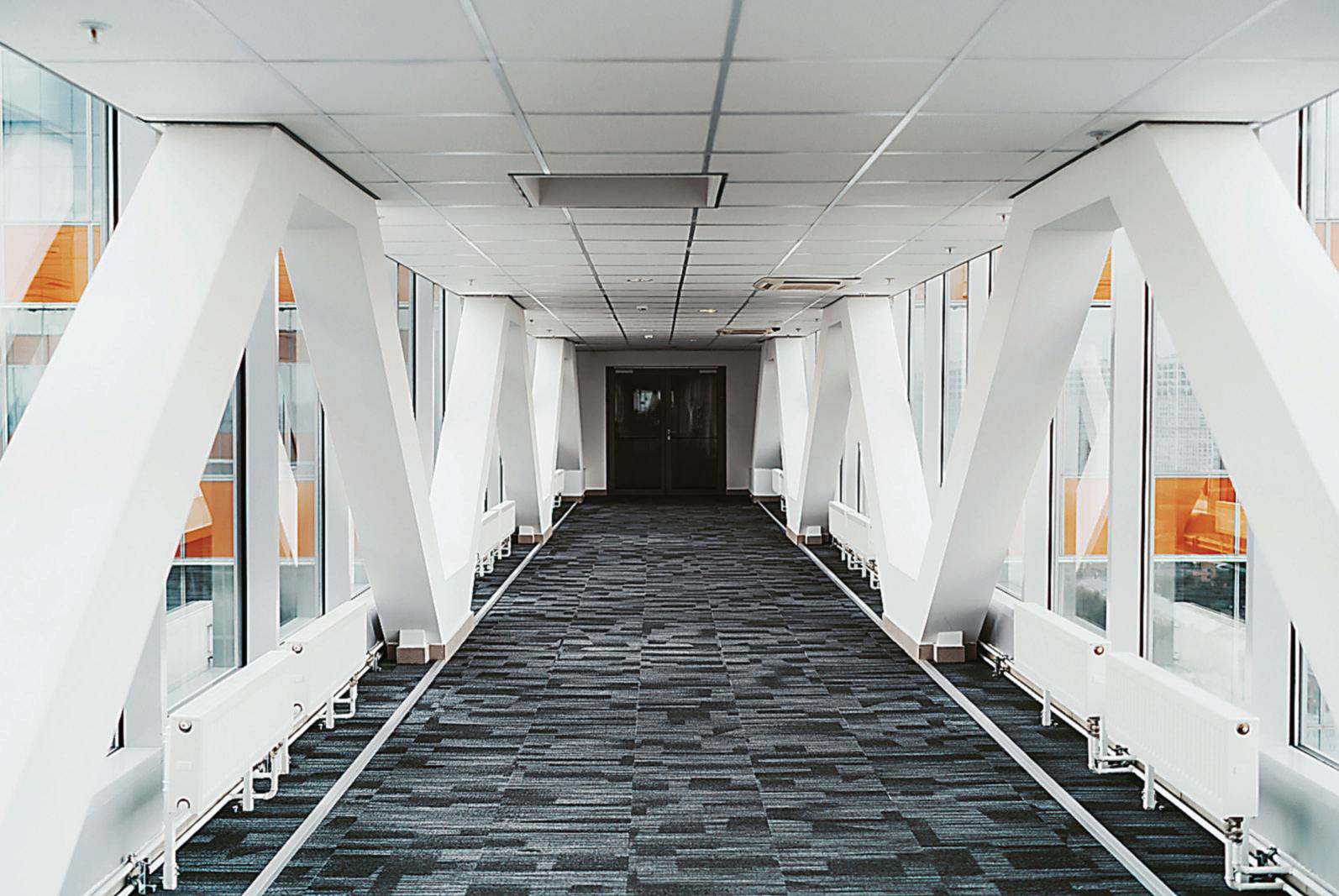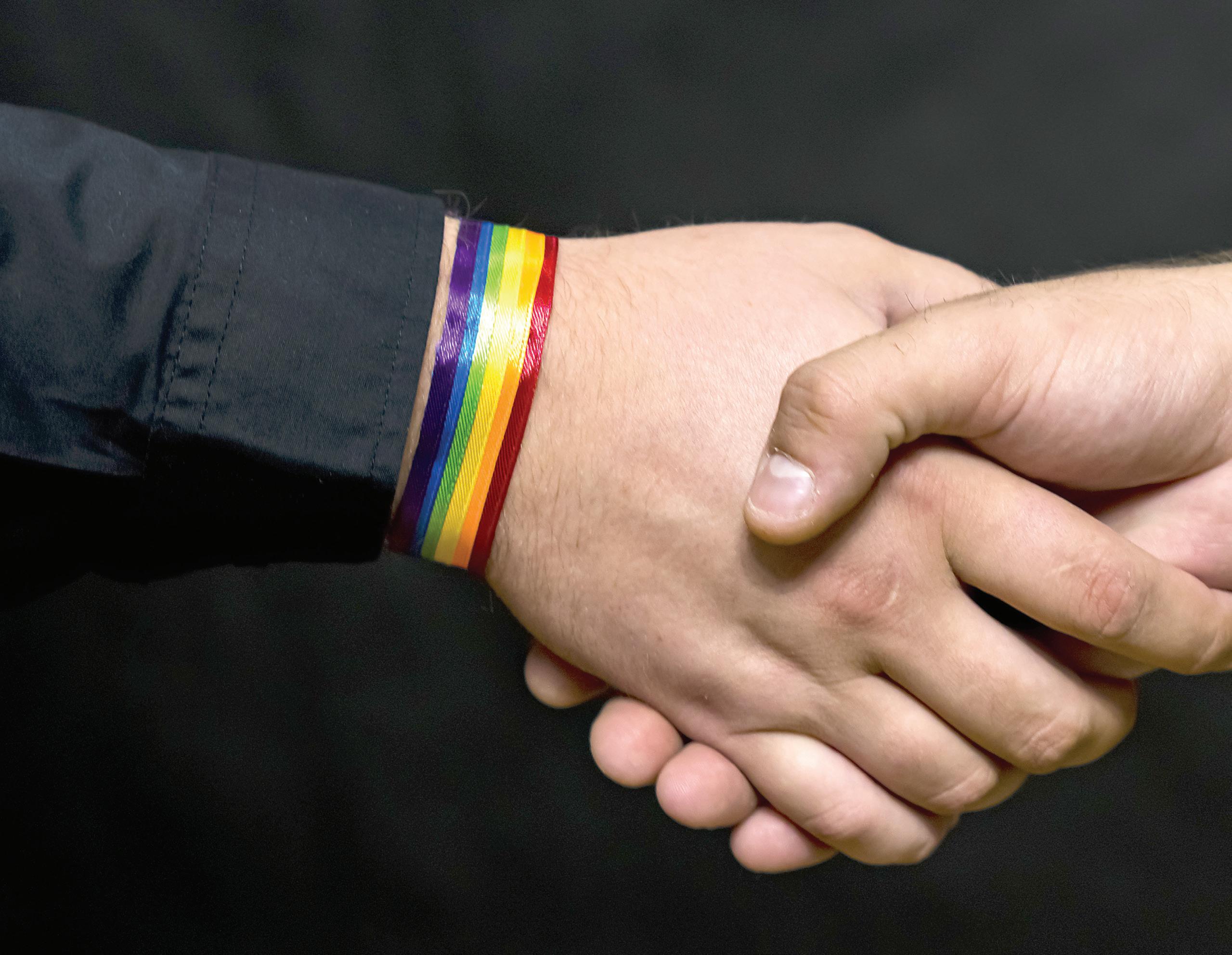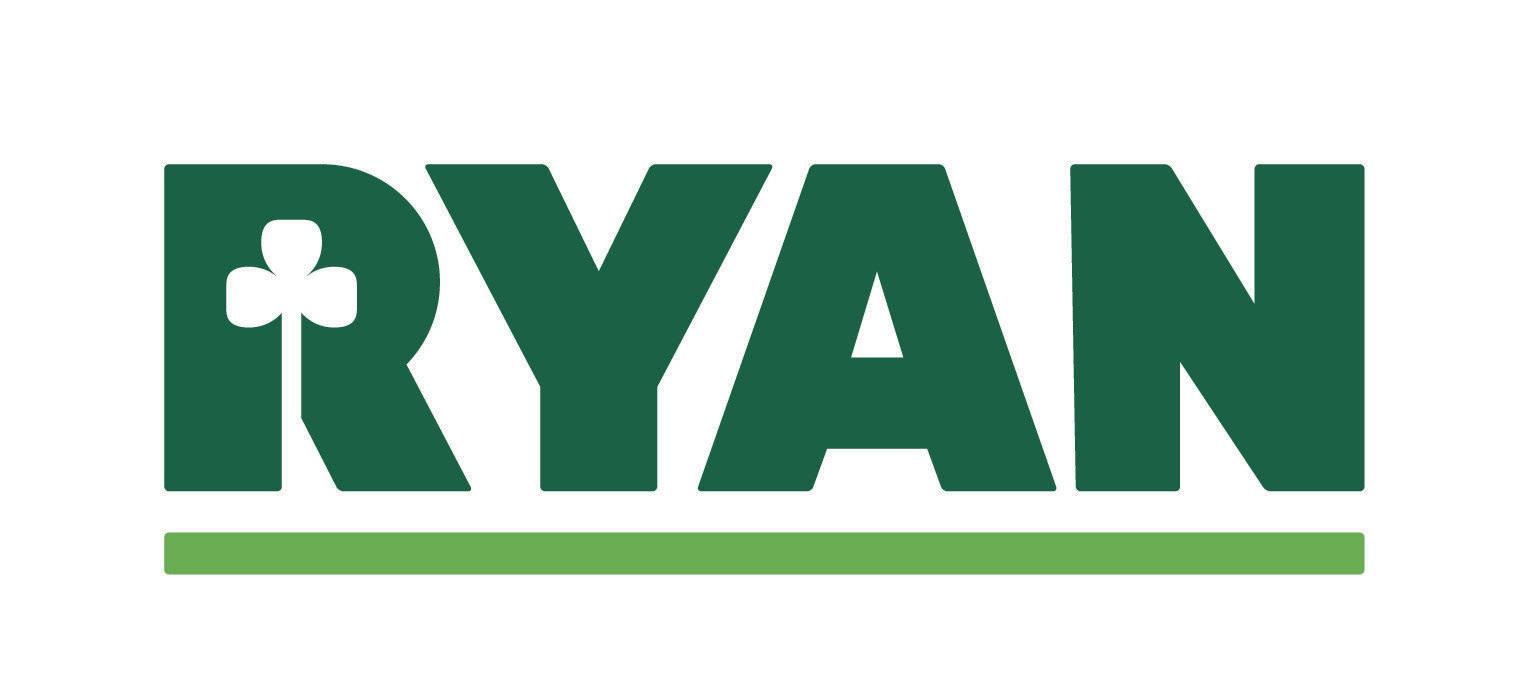
17 minute read
Sanjusan Restaurant
Pasta for Madame Butterfly
By Carla Waldemar
Note to trend-watching diners: Fusion menus are back in fashion, at least if the bold-name chef orchestrating them is Daniel del Prado (Marina, Colita, Rosalita and more in Southwest Minneapolis, plus Uptown’s Burch Steakhouse). His newest venture, however, is anchored in the North Loop, occupying a historic building that also houses the restaurant Kaiseki Furukawa. Having its Japanese chef so close to mentor him piqued del Prado’s culinary curiosity, resulting in the likes of togarashi on his Marinara pizza (Yes, he’s installed a woodburning oven) and cavatelli pasta sauced with sake.
The setting—chic, spare and dressed in gleaming white—invites the (well-spaced) diner to sink into banquettes or grab a stool at the open kitchen to investigate the small but well-curated menu of apps while sipping what’s clearly the bar’s most popular cocktail, the Mican: gin jazzed with a strong, perfumy accent of tangerine, server with a “mandarin cloud” which looks—tastes—like cotton candy. The drinks menu also offers wine and sake.
A dozen-strong list of apps ($9-16) blends Japanese and Italian ingredients in virtually every creation, from the straciatella soup brightened with wasabi to the panzanella salad melded with bonito mayo. Our decided favorite of the night was the plate of pork gyoza, whose chewy noodle wrappers blended the meat with earthy, chewy woodear mushrooms in a rich, foie gras-enhanced broth balanced with the brighter flavorings of nori and scallions. Great dish!
We also made quick work of a plate of deepfried eggplant fingers called katsu, served with a blissful, basil-scented red cabbage slaw awakened with occasional pops of fresno chilies. Cole slaw never tasted so good. However, a dish of cauliflower karaage—florets flecked with bits of blue cheese in a chili vinaigrette—proved underwhelming, as did the order of fried prawns with shiso lemon. Bound in translucent wrappers, the shrimp arrived overcooked and stodgy, bereft of interest.

Next time: the squash arancini rice balls viewed at an adjoining table, moistened with a brown butter mayo, enriched with agrodolce and hazelnuts. Or the Wagyu beef nigiri, built upon bone-marrow risotto, ponzu crumbs and horseradish.
Tonight, on to the pastas—a quartet of offerings ($16-26) generously portioned for sharing. The pea-green nuggets of cavatelli pasta, invitingly sauced with a crunchy pistachio pesto, sake, Parmesan and chives, delivered a win. But the squid ink papardelle (all pastas are housemade, assured our server, a former waitperson at Meritage) was overly salty and hard to finish. Italians aren’t crazy about saucing seafood with red sauce, and this version proved those canny cooks were right: the Bolognese overpowers the shreds of sweet, sweet seafood, abetted by lusty Pecorino cheese. Next time: the shrimp ravioli in XO butter or the fettucini ai uni, starring king crab with basil and serranos.
Or, wait! Next time, one of the gorgeous pizzas we viewed emerging from that hot, hot oven: six choices ($11-18), from a traditional Margherita (mozz and basil) or Quarto Formaggi to the Verdi, piled with miso pesto, burrata cheese, walnuts and Parmesan. Or a foray into the list of Yakitori—all sorts of chicken bits, from drum to wing to skin, $2-5. And another of those cloud-topped Micans, please.
SANJUSAN
33 N. 1ST Avenue 612-354-7763 Sanjusanrestaurant.com

Photo courtesy of BigStock/neuravnoveshenui

COVID WORK LIFE:
Careers Created in 2020
By Holly Peterson
COVID upended almost everyone’s life. People lost jobs, switched industries, and found unique ways to pivot and re-organize in response to the pandemic. Very few people are living the same life now as they were in early 2020. From fitness instructors to gig workers and more, we got the scoop on how COVID impacted our professional lives.
GIG WORKER / ARTIST – NIK C.
Many industries completely shut down in lock down. Nik worked in two such industries. “Covid collapsed my work life completely,” they say, “I worked large events [and] as a freelance film worker…Both jobs came to a sudden halt [and] I lost all sources of income.” Worse, “my healthcare was essentially taken away from me.”
“There was a dark period of no work at all.” But Nik made the best of it. “I took [lockdown] as a means of pursuing what I was passionate about,” they explain, “I started work on my book.”
Nik has picked up gigs as restrictions ease. Shipt, the grocery delivery service, is currently their primary source of income. “I [get] to choose my hours and my region…[I don’t] lose focus on my art like I did with other 9-5s… My art, my earnings, my choices.”
FITNESS INSTRUCTOR – SARAH W.
“The gym has gone through some major losses-especially early on when we were trying to figure out how to adapt to city wide closings of gyms,” says fitness instructor Sarah W, “[My gym] lost a lot of clients.”
Sarah’s gym adjusted, focusing on bringing fitness classes and one-on-ones into their clients’ homes via Zoom. “I have completely had to revamp how I reach clients in the fitness setting,” Sarah explains, “People are so hesitant getting back into a gym.”
There are perks to online fitness instruction. “People who are not comfortable working out with others love that they can be in the comfort of their homes and not worry about others judging them,” Sarah says.
Online sessions also have their drawbacks. Sarah mentions how hard it is to “make sure everyone is using the correct form or offer modifications.” The camaraderie established at in-person classes is also harder to come by online, although Sarah encourages her clients to “come a few minutes early to chat with the instructor or stay a few minutes late to chat with the other class goers!”
MSP COURIER –DON, SUE, AND CHARLIE F.
“When they shut down the country our workload level went down by fifty percent in two days,” says Don, who owns and operates MSP Courier with his wife and son. Luckily, “within a month we were back to normal numbers and about two months later we were doing record numbers.”
Many of these new jobs involved transporting COVID in some form, which meant new risks. “All our drivers were kind of apprehensive at first,” says Don. Drivers were careful, though, and it was only late last fall that a driver contracted the first and only case of COVID at the company. He has since recovered and, considering the volume of COVID-related materials that the company works with, everyone involved is grateful that only one person has gotten sick.
The increase in clients also meant an increase in hiring abilities. Charlie, who had coincidentally just left a career in experiential marketing, was able to hire friends who had lost their jobs. “I was happy to help people who I know are great workers,” he says.
STUDENT LIFE DIRECTOR –EVIE P.
College students – and the professionals who coordinate their lives – have seen huge changes this year. Evie, who coordinates student life for college students explains, “[M] aking adjustments within our program to offer a safe and robust experience for our students in the midst of a pandemic…has meant adjustments to student housing, more openness to hybrid learning and…[policies] to assist students if they are sick or exposed to COVID.”
“Overseeing Covid protocols [for students] is exhausting and stressful,” says Evie. Keeping students safe and happy sometimes seem like mutually exclusive goals, but Evie’s emphasis on open communication with students has made a difficult job a little easier.
The pandemic has also helped her institution clarify the importance of its mission. “The pandemic has forced higher education to think again about the product (education) that they offer,” she muses, “Our organization has done a great job in thinking through this and being reminded of what we do and why we do it.”
S & S GLASS COMPANY – SUE AND SCOTT W.
“Never in our wildest dreams did we ever think we would have encountered a pandemic in our life,” says Sue, of S & S Glass Company.
After the initial shut down, S & S Glass had to figure out how to navigate their status as an essential business. “We had a meeting with our employees and said we were able to work moving forward, but [would only accept projects] where we could make sure our people were safe.” Despite the company’s efforts one employee quit, citing his “anxiety about getting sick.” So far, the team has remained healthy.
S & S Glass Company found itself uniquely suited to build the increasingly popular glass barriers, partitions, and shields for local businesses. Neither Sue nor Scott felt right capitalizing off the pandemic so they forewent “the markup we would [normally make] on other products.”
The other significant change for S & S Glass Company is in office culture, “We no longer have a open door policy…we only see clients by appointment,” Sue says wistfully, “Life at our office is very different.”
NURSE PRACTITIONER – ASHLEY T.
Working as a nurse practitioner was scary at the start of the pandemic. “I would come home, change in the garage, and take a shower before I saw the kids. I was scared to hug them,” Ashley says. Ashley’s workplace has worked hard to keep their clinic safe – and they have been successful.
No one who works at the clinic has contracted COVID. “Everyone has been super diligent about masking and hygiene.” Just as important, the team has communicated carefully with patients to make sure that “people who are ill aren’t coming into the clinic.”
Telehealth has been a gamechanger for patients and health professionals alike. Patients who are sick – or who simply have tight schedules – can speak to health professionals from the comfort of their own homes. “That’s been good for some things [but] it’s challenging sometimes because you don’t always have all the information you need,” says Ashley.
Ashley’s primary concern as a nurse practitioner now is patients who put off seeing a doctor for the last year. “A lot of screenings [for blood pressure issues, uncontrolled diabetes and things like that] have been delayed,” she says, “The world is kind of scary right now, [but] we want to take care of our patients and keep you safe and healthy,” she says.
It has been a year full of changes, both professional and personal. Let us know what changes you have dealt with in the last year and how they have impacted your day-to-day.
Photo courtesy of BigStock/SkyNext

DOWNTOWN EXODUS:
Stark Skyways
By Ryan Patchin
In 2008, I moved into the hip, forever upand-coming Steven’s Square neighborhood of Downtown Minneapolis. Sitting adjacent to Loring Park and Downtown South—and central to pretty much everything. A good place to start.
I remember my quick cycle-route to work: third avenue to fifth street, down to first avenue. The company I worked for had space in the Butler Square building, which granted me a “gold-pass” to the Lifetime Fitness that was located in the basement of the Target Center— directly across the street from work.
That pass saw zero workout time, but it allowed me to roll out of bed each morning and hop on my bike, knowing I’d have a secure place for my whip and a post-ride shower before work. On occasion I’d sit in the hot tub for a few minutes before starting my morning routine.
The rest of my workday was spent off the ground. I worked on the seventh floor of the Butler Square building, and if I went anywhere, I took the skyways. I prided myself on my knowledge of the skyways and I used my lunch breaks to explore the ins and outs of the second story system. Restaurants, salons, department stores, kitsch markets, fancy eyewear—it was all in the skyway.
The city had a vibrant bustle; things were open. The office towers that cut our skyline were all but fully occupied and sports stadiums were starting to pop up like Chipotles.
But there’s been a noticeable shift—our city’s center has been dealt multiple blows, emptying out the towers. And, in some cases, the firms that occupied said towers have relocated their operations. Twelve years after my initial downtown immersion, the city’s entire
vibe has changed. What is to become of the vertical space that densifies our downtown district?
The Minneapolis Downtown Council estimates office buildings sit at 15 to 16 percent occupancy, according to KTSP. Downtown occupancy is typically closer to 90 percent. Target was the latest corporate giant to announce a move. The now-empty City Center space, which used to house 3500 employees, is poised to create a vacuum for businesses that relied on their foot traffic.
Ted Farrell, President of Haskell’s Wine and Spirits called the city a “ghost town” and was worried for the future of Downtown. “I think it’s horrible it’s an ominous sign of things that are going to happen downtown,” Farrell predicted. Steve Cramer with the Minneapolis Downtown Council said it was early to tell what will fill the City Center space, according to March interview.
Negative absorption is like free agency for commercial real estate. Spaces in “lame duck” tenancy situations won’t have their leases renewed and all that space is absorbed back into the market. In the first quarter of 2021, the Twin Cities saw more than 1.5 million square feet of negative absorption. One million of those square feet of leased spaced left with Target.
Laura Moore, vice president of office brokerage services at Colliers points to safety concerns as the primary cause for firms leaving the city. “It’s addressing what Minneapolis is doing for the volatility that is happening in the community. I know it’s not going to be solved overnight, but the worst thing that could happen is not addressing it. I feel like it hasn’t been addressed. It’s been a topic that people are uncomfortable talking about because it’s calling it for what it is and it’s a problem,” Moore said in an interview with FOX 9.
Adding to the strangeness of the Downtown exodus is the amount of construction going on. New luxury condos have sprung up all over Downtown, with 2.4 million square feet of new real estate currently under construction in Minneapolis. How can a city facing occupancy issues also see a building boom? Steve Cramer says, “It’s not all doom and gloom but I think you have to be realistic about entering into this period of a reset for our downtown economy.”
In an email sent to employees, Target stated that employees who won’t return to their offices in City Center will still have a home-baseoffice, either in Brooklyn Park or Minneapolis. Target, like many corporations, will likely shift to a hybrid work environment where employers would still see employees at an office a couple of days per week, or a few days each month. Properly staggered, this sort of work model could support a rebirth of skyway and street-level businesses.
And the vacuum in space left by giants like Target could create opportunities for smaller businesses to take office space. Or the space could evolve into a workshare model. It could be the future.
We have a few more hurdles to climb before we can start to accurately predict the future of our Downtown. I watched Minneapolis rebound from the Murderapolis days—and it rebounded in a big way. I have complete faith in our ability to do it again.
Conversations with

Join us for a Facebook Live panel discussing the impacts of COVID-19 on LGBTQ frontline workers, businesses, and communities.
April 28th
5:30-7:00 PM Facebook.com/PFundFoundation
COVID-19 Impacts on the LGBTQ Business Community

CONSTRUCTION BUILT ON CORE VALUES
Ryan Companies, known for its commitment to providing the very best in commercial real estate, has started a new employee resource group.
By Kassidy Tarala



Photo courtesy of BigStock/Vjacheslav Kozyrev

Dating back to the 1930s, when it was originally founded as Ryan Lumber and Coal, Ryan Companies has a long history of working in construction, design, and development of buildings.
“At Ryan Companies, we believe the value of the buildings we design, develop, finance, manage, and construct is about more than dollars and cents—it’s also about the value they bring to the people who use them and the communities that surround them,” says Jacob Yates, construction analyst at Ryan Companies. “That’s why we focus first on the ‘why’ so we can give life to your vision and achieve the best possible outcome.”
As a national leader in commercial real estate services, Yates says Ryan Companies knows that its customers are as unique as its projects. “That’s why, day after day, we’re driven to uncover their stories. To be inspired by what inspires them. To bring the right people to the table so we can col-
Stay Inspired This Summer

Learn a new skill or develop a passion project at MCAD! In-person and online summer adult courses range from graphic design, illustration, and user experience to photography, figure painting, pattern design, and more.
Registration opens April 26 at mcad.edu/ce. Take advantage of an early-bird discount by May 10.
Photo courtesy of BigStock/Rido81

laborate on a deeper, more engaging level,” he adds. “Together, we build something far more profound than the physical presence of a building. We build the backdrops to life’s stories.”
The core values of Ryan Companies— safety, integrity, respect, stewardship, family, excellence, and fun—are what define the company’s culture, Yates says. “These are more than words in a mission statement; they are the inspiration that guides our decisions and shapes our belief that we offer something no one else can,” he says. “In the end, your building is better, your experience working with us more enjoyable, your community more vibrant, and your project site safer— all because we embrace our values each day.”
From commercial real estate project conception to completion and beyond, Yates says the team at Ryan Companies puts their hearts into creating spaces that bring each client’s story to life.
Ryan Companies’ services include: construction; architecture & engineering; development; real estate management; and capital markets. And it specializes in the following sectors: health care, hospitality,iIndustrial, mixed-Use, multifamily, office, retail, and senior Living.
Ryan Companies currently has fifteen offices across the country in Phoenix, Arizona; Tucson, Arizona; San Diego, California; Tampa, Florida; Atlanta, Georgia; Chicago, Illinois; Cedar Rapids, Iowa; Des Moines, Iowa; Minneapolis, Minnesota; Rochester, Minnesota; Kansas City, Missouri; Austin, Texas; Dallas/Fort Worth, Texas; and Seattle, Washington.
“Ryan’s story was built on the foundation of integrity, honesty, and community. And a belief that we offer something nobody else can. By creating diverse, inclusive, and welcoming workplaces where all team members can grow and thrive, we also create a culture where we share in each other’s successes and where we create new stories of success for our customers and communities,” Yates adds.
Not only are the customers and communities important to Ryan Companies, but its employees are the backbone of the company, and they are regarded as such through Ryan Companies’ various employee resource groups (ERGs).
“As part of Ryan’s broader diversity, equity, and inclusion strategy, we wanted to create more safe places for our employees to connect and feel part of the Ryan family. So Building Pride joins our previously established Women’s Inclusion Network and other new groups such as Amigos@Ryan for our Latinx employees and BRilliance for our Black employees,” says Bryce Tache, senior director of diversity, equity, and inclusion. “We also have a veterans group forming, and others planned in the coming months. All our ERGs are employee-led and open to all employees.”
The newest ERG, Building Pride, offers employees a safe and welcoming space. However, Tache says it’s much more than that.
“Building Pride is more than a safe space. The vision the group developed is to create a more inclusive work environment through education, communication, and cultural awareness. We believe that attracting, developing and retaining employees that reflect the diversity of our customers is essential to our success,” he says. “Our LGBTQ+ team members are part of the Ryan family, leading by example to promote and improve diversity, equity, inclusion, and belonging.”
“At Ryan, we celebrate people of all sexual orientations, gender identities, and gender expressions,” Tache says.
For more information about Ryan Companies, visit ryancompanies.com.



